by Paul Dyson
Photographs by Stanley Horrocks
Higher Broughton has really been our family home. My sister and I lived there for most of our pre-adult lives and we both returned hundreds of times up to 2019 to visit our parents there. Our mother spent over seventy years there as a resident. However, the one who was truly steeped in the area was our stepfather, Stanley Horrocks, who was born in 1922 into a large family in Wally Street, and had an upbringing that was in many ways typical of a working-class Salford child between the wars.
In his early years his world was largely that of small Victorian terraced houses on cobbled streets which were playgrounds in themselves with very little traffic. Just beyond the top of the street was the imposing red-brick St James’ Church, opened in 1879 when the Higher Broughton population was growing. The church and its community were significant to him his whole life.
St James’ school was just across the main road, Great Cheetham Street East. Not far off with views towards Manchester were ‘The Hills’, a patch of open ground between the built-up areas. Further afield were Mandley Park, Albert Park and, a tram ride away, Heaton Park, which the family used to visit for picnics and play. More adventurous expeditions were to The Cliff and The Landslide above the River Irwell, or to Clowes Park amidst real suburbia, and a great treat was to be taken to visit relatives on a farm at Simister.
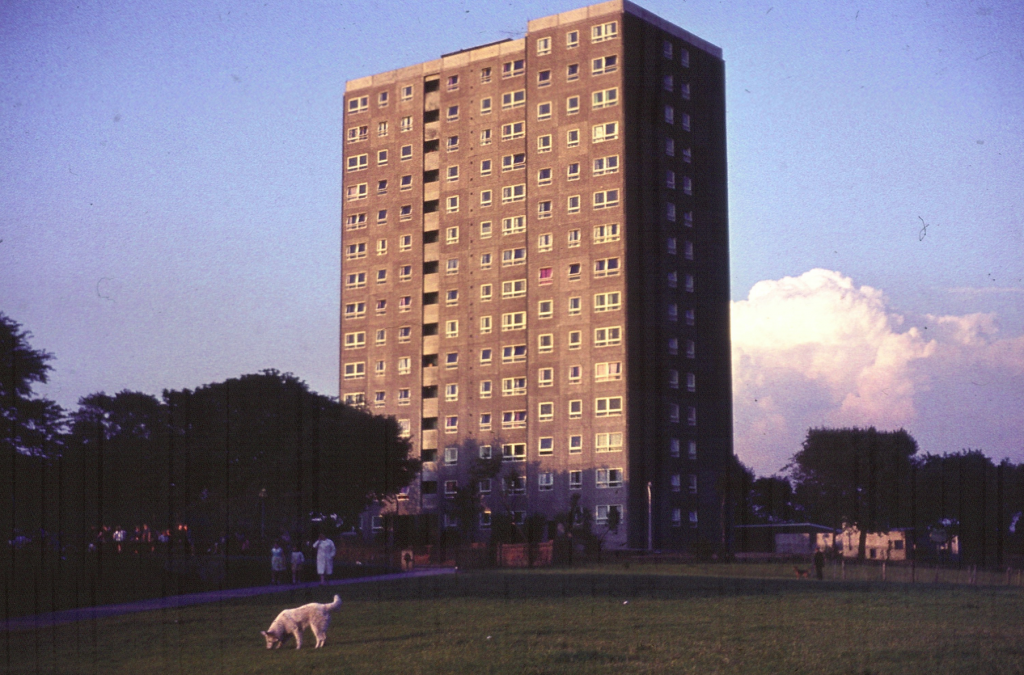
It’s been hard to imagine but until the mid-1800s Higher Broughton itself was rural – a sparsely populated township to the north of Manchester, with most of the land owned by the Clowes family of Broughton Old Hall. They began to allow wealthy business and professional men, some of whom were immigrants from various parts of Europe, to build large mansions in The Cliff and Broughton Park and handsome terraces along Bury New Road, desirable districts well away from industrial dirt and overcrowding. It was prosperous merchants from the Ottoman Empire who built the Greek Orthodox Church of the Annunciation on Bury New Road in 1861. Their work took them down to the centre of Manchester and from 1865 omnibuses then horse trams began to transport these commuters – some vehicles and horses were stored at Manchester Carriage Company’s depot at Market Place.
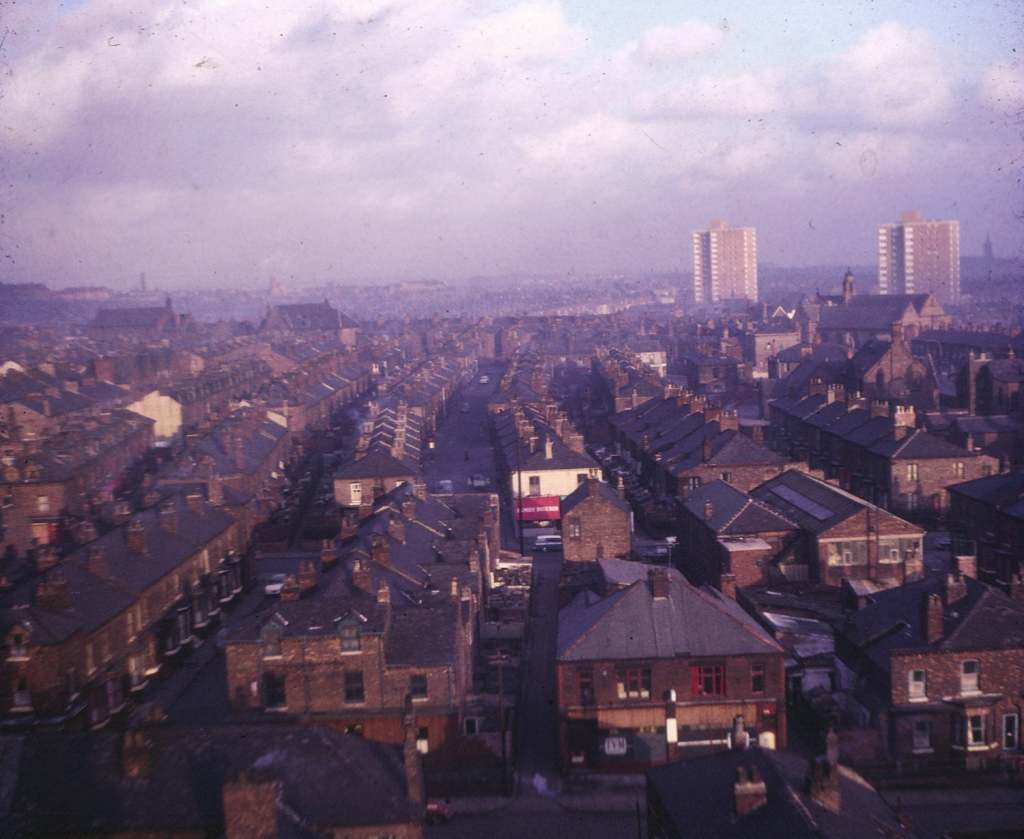
Towards the opposite end of the social scale were the tradesmen and workers, both skilled and unskilled, who moved with their families to occupy the two-up two-down cottages that sprang up in the 1870s. These were built in parallel streets of nearly identical terraces on Clowes land to the east side of Bury New Road, extending towards the meandering boundary with Manchester and northwards to Devonshire Street. A new parish of St James was carved out of St John’s (until then the parish church for the whole of Broughton) to provide an anglican worship centre and school for the new population. It was more or less bisected by Great Cheetham St East, the route to Cheetham Hill, a grand name for what had started as Cow Lane. The 1889 Ordnance Survey map shows clearly the varied character of the district.
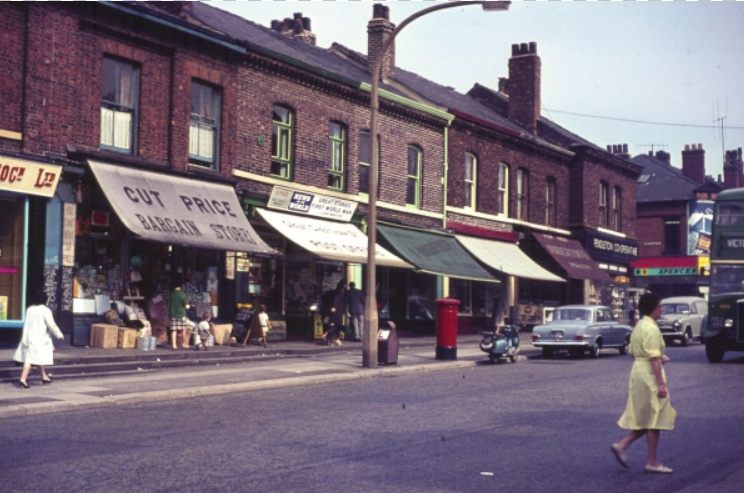
Higher Broughton developed in a similar manner over about twenty years and then remained essentially the same until the 1970s. Wilfred Street was extended as Leicester Road and more parallel streets of somewhat better-quality red-brick terraces were built on either side of it as far as Mandley Park and Wellington Street, with similar development on the east side of Great Cheetham Street. There were few open spaces but Mandley Park was a vital recreational lung for all ages, with bowling greens, tennis courts and swings, and it contained the branch library. For amenities the population had a great variety of shops all the way up Great Cheetham Street and many corner shops in the side streets. Social facilities included three churches, three primary and three secondary schools, four cinemas and four pubs, despite the Clowes family always restricting the building of pubs on their land. From the introduction of electric trams in 1901 there was easier mass transport to Manchester city centre, Prestwich and other parts of Salford.
As property aged and declined beyond acceptable quality, redevelopment began in the 1960s, when old houses and terraces on Bury New Road were demolished. Tower blocks were not a major feature in Higher Broughton but of those that were built five still exist; Oakhill Court commanded higher ground just beyond Mandley Park as selective clearance was done in Hightown; Cheshill Court and City View arose on Marlborough Road, Ascot Court (luxury flats) and Floral Court on Bury New Road.
The major demolition and rebuilding of the oldest terraced streets took place between 1976 and 1982, removing over 1,500 dwellings and shops on twenty-six streets and replacing them with mainly two-storey, shorter terraces in a more spacious and less layout, reducing the density of both housing and population. Of course, this meant great disruption of communities, loss of shops and familiar places. Some of the red-brick terraces had renovation schemes and are still there. Others, in the area of Hampshire Street, often privately owned, were bought by Salford Council in the 2000s and demolished to make way for the Broughton Green scheme, a seven-year project aimed at bringing 700 new homes, a library, a youth club and sports fields.

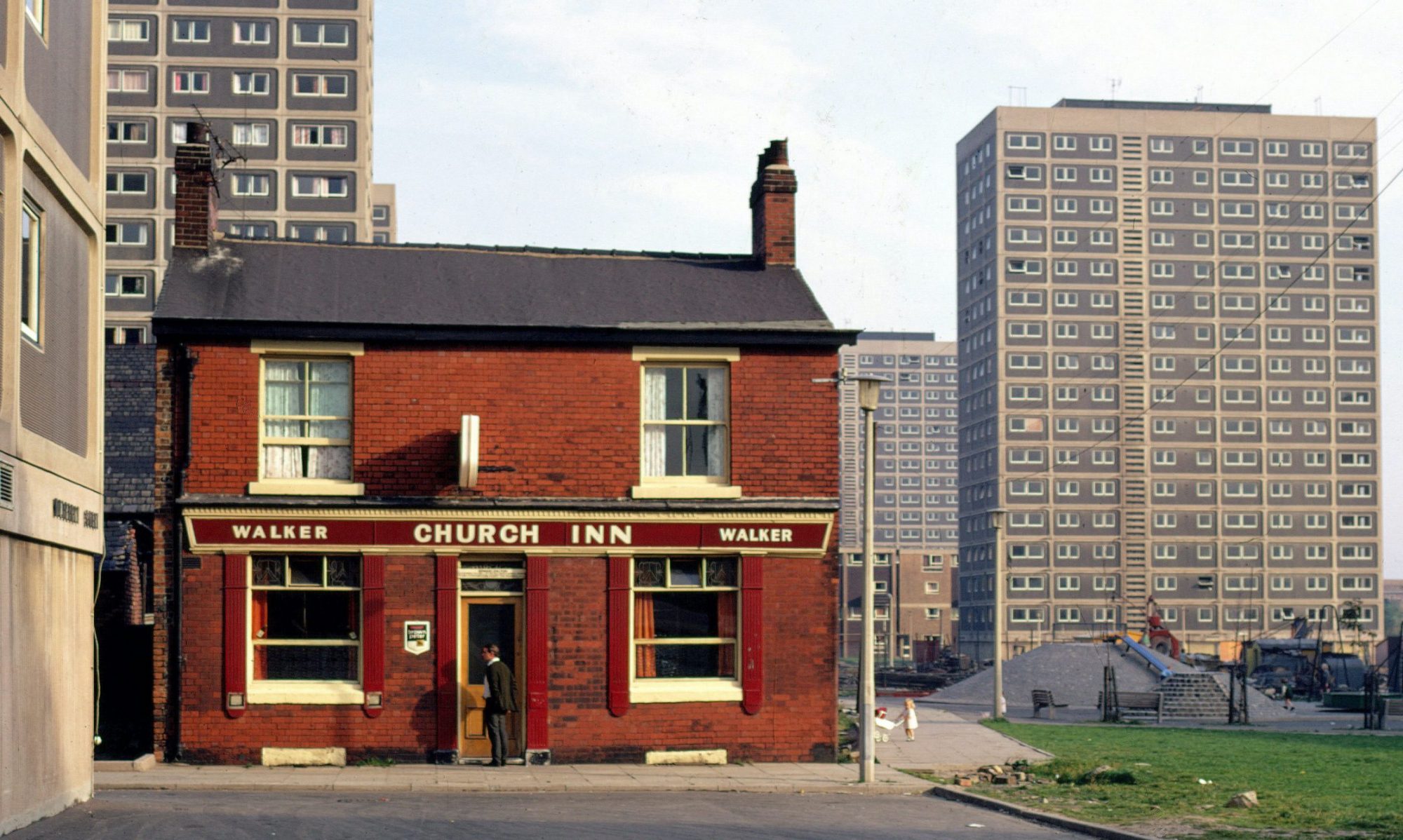
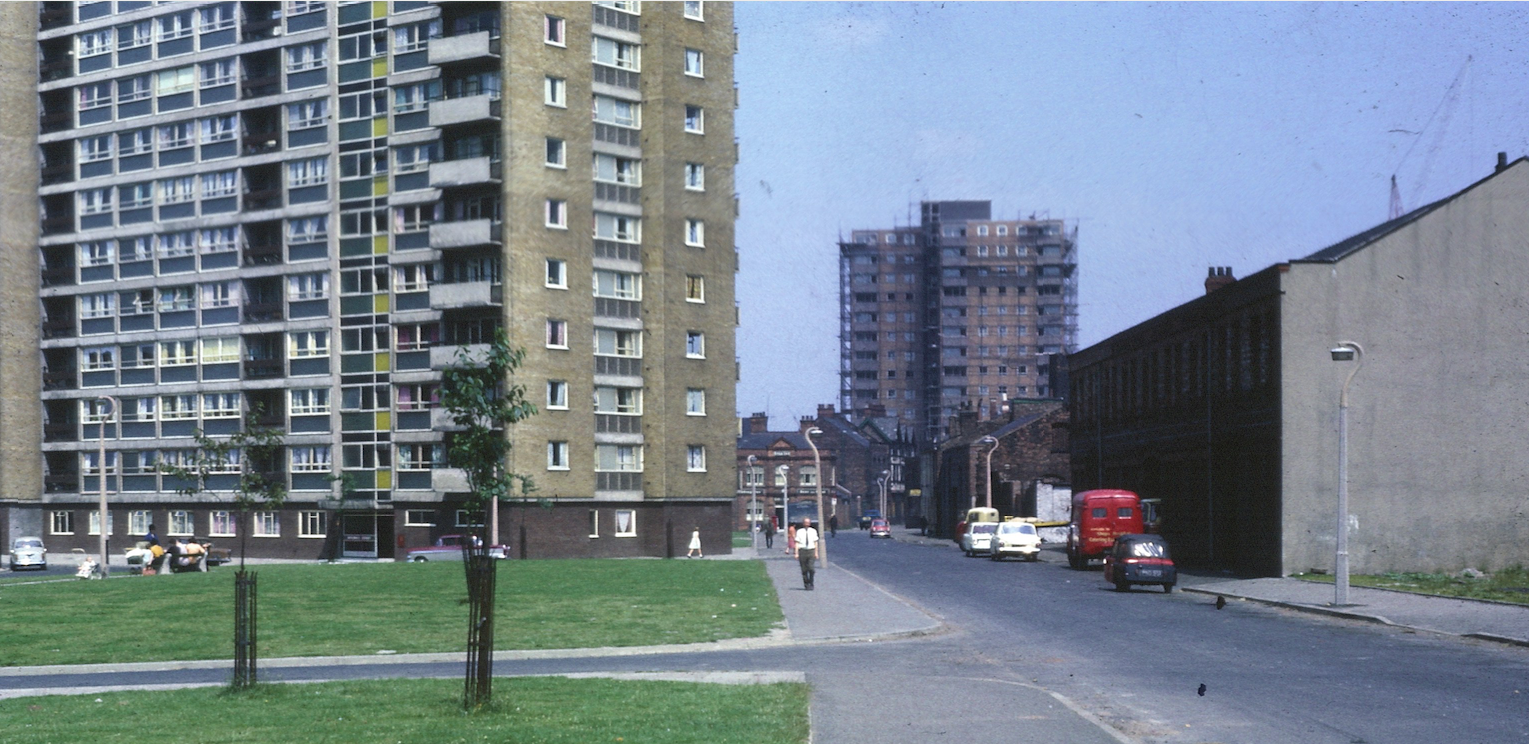
Interesting read. My mother was a neighbour of Stan Horrocks in Wally Street. She was married at St James and I was baptised there. We lived on Rigby Street before it became part of clearance and we ended up on overspill in Little Hulton. My paternal Nanna lived on Pemberton Street, Hightown and when that was duly knocked down, she ended up in Hulme. Wonder if any photos of Pemberton St exist? It was a long road but remember playing out on the street late 50’s.
Hi Jude. Thanks for your comment and strong memories of the area near St James’. You can find the St James’ registers transcripts with your family records on the free Lancashire Online Parish Clerks website at: https://www.lan-opc.org.uk/Salford/Broughton/stjames/index.html
I don’t know of any photos of Pemberton St, apart from a misty one across the rooftops from St James’ and an aerial shot at: https://www.britainfromabove.org.uk/en/image/EPW062719. There is a chat forum where it gets the odd mention at: https://www.manchester-forum.co.uk/index.php?topic=5580.1185. Paul
was your Mam Annie and do you have a brother, Barry?
Hi Fred
Afraid not – I’ve no relatives with those names.
Kind regards
Paul
Brilliant . loved reading this history . My family all lived I Higher Broughton , Peru St until it was purchased for redevelopment of ?swimming baths .Fabulous memories . We were the Batterton and Hynes family.
Hi
Thanks for your comment.
Peru St became Pentlands Avenue alongside Broughton Baths. According to Google Maps there is still a sign for Peru St 7 on the wall of the Dover Inn at the corner of Fenney St.
Best wishes
Paul
I lived at No 7 Walley St opposite the Horrocks family. I went to school at St James` until dad, who was in the army was posted to Germany in 1959, & we went with him. When we returned I attended North Salford Secondary School for Boys, 1962-7 & lived in Ivy St & then 24 Tully St.
Hi Steven
I have a few photos of Wally St, Ivy St and Tully St and also of North Salford School, which I could send as e-mail attachments, if you are happy to share your e-mail address.
Best wishes
Paul
My first home was Maple st just down the road from St James church my mum and Dad married there as was his sister we moved to Heaton st and had Manley park as our play area it was fantastic life the park had a bowling’s green and I think it was 5p to play
Hi Samantha
Thanks for your comment.
You should be able to find a transcription of your family marriage records on the free Lancashire Online Parish Clerks website at this link: https://www.lan-opc.org.uk/Salford/Broughton/stjames/index.html
I have a couple of photos of Mandley Park and Maple St which i could send as e-mail attachments if you’re happy to share your e-mail address.
Best wishes
Paul
Lived in ivy Street which was the next street to wally St so many memories
Hi Susan
Thanks for your comment.
I have a few photos of Ivy St and nearby streets, which I can send as e-mail attachments, if you’re happy to share your e-mail address.
Best wishes
Paul
A great read, I was born in Wally St, baptised at St James & attended St James as we’re most of my family. All the parks you mentioned, the Landslide & Tanyard were our playgrounds, with Saturday matinees at the pictures. My family lived there in the 50s when your father did. We moved to Cheetham hill,then Bury. I only have fond memories of Salford.
Hello Mel
Thanks for your comment and memories.
You should be able to find transcriptions of your family baptism and marriage records on the free Lancashire Online Parish Clerks website at this link: https://www.lan-opc.org.uk/Salford/Broughton/stjames/index.html
I personally remember your brother Malcolm and sisters Marlene and Barbara from St James’.
I have some photos of Wally St and nearby, which I could send as e-mail attachments, if you are happy to share your e-mail address.
Best wishes
Paul
A great read. I lived on St James Road – nextdoor to Jack Maurer’s bakery in the early 90s before moving to Oakhill Court at Mandley Park for 10 years.
Even in 30 years the area has changed so much – and not for the better.
We lived across from St. James Church on St. James’ (James) Road (different spelling on either end of the road!) between 1953 and 1997. Saw a lot of changes in the area but, there are still a lot of old, original 1900’s houses in the area, especially Great Cheetham Street East. Love to see the old photos and recognize the places of my childhood. Jack Maurer was THE best bakery and people would travel miles in their Rolls and Jags and Mercs on a Sunday morning for the world’s best bagels… as I would walk a few yards up the street for mine!
Hi Paul,
A fascinating and really informative read, my mum and dad were good friend’s of your stepfather Stanley, my mum and dad were Leonard and Brenda Starkie, my dad’s family lived on Walnut Steet, my dad told me many of his childhood tales, sadly in the last couple of years of his life reminiscing, he passed away in July 2018.